14) Coordination and response
1/66
There's no tags or description
Looks like no tags are added yet.
Name | Mastery | Learn | Test | Matching | Spaced |
|---|
No study sessions yet.
67 Terms
Define ‘Reflex action’
A means of automatically and rapidly integrating and coordinating stimuli with the responses of effectors (muscles and glands).
Define ‘synapse’
A junction between two neurones.
Define ‘sense organs’
Groups of receptor cells responding to specific stimuli: light, sound, touch, temperature and chemicals.
Define ‘hormone’
A chemical substance, produced by a gland and carried by the blood, which alters the activity of one or more specific target organs.
Define ‘adrenaline’
The hormone secreted in 'fight or flight' situations.
Define ‘Homestasis’
The maintenance of a constant internal environment.
Define ‘gravitropism’
A response in which parts of a plant grow towards or away from gravity.
Define ‘phototropism’
A response in which parts of a plant grow towards or away from the direction of a light source.
What does the mammalian nervous system consist of
1) The central nervous system (CNS): consisting of the brain and spinal cord
2) The peripheral nervous system (PNS): consisting of the nerves outside of the brain and spinal cord.
The role of the nervous system
coordinating and regulating body functions.
What do neurons do
Electrical impulses travel along neurones. This is how information is sent through the nervous system.
What is a nerve
a bundle of neurons.
What are the neuron types
Sensory neurones
Relay/intermediate neurones
Motor neurones
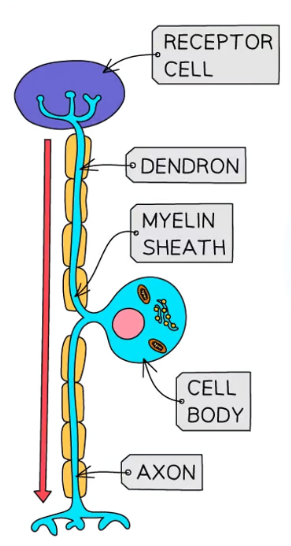
What neurone is this
Sensory neurone
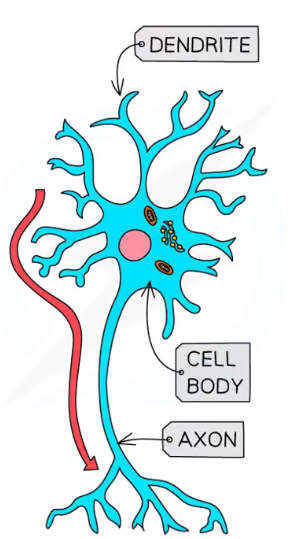
What neurone is this
relay/intermediate
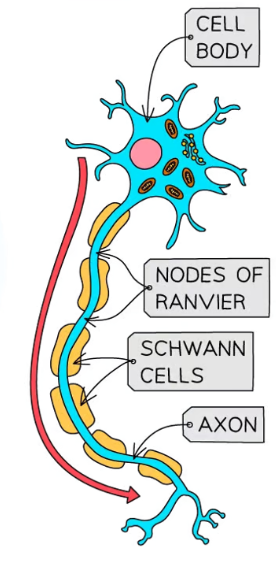
what neurone is this
motor neurone
Function of a sensory neurone
Sensory neurones carry impulses from sense organs to the CNS.
Function of relay/intermediate neurones
found in the CNS
connect sensory and motor neurones.
Function of motor neurones
carry impulses from the CNS to effectors.
What is a voluntary response
A voluntary response is one where a conscious decision is made to carry out a particular action.
What is an involuntary response
An involuntary response (a reflex) does not involve the brain as the coordinator of the reaction, so you are not aware of the action until it is carried out.
Reflexes are quick and help minimise damage to the body.
Describe the reflex arc
1) A stimulus is detected by a receptor and it generates an impulse.(touch, pain etc).
2) A sensory neuron sends the electrical impulse to the spinal cord (the coordinator)
3) The electrical impulse is passed on to a relay neuron in the spinal cord.
4) The relay neuron connects to a motor neuron and passes the impulse on.
5) Motor neurone carries impulse to an effector (muscle).
6) The effector carries out the response (muscle contraction, etc).
Outline the reflex pathway
Stimulus→ Receptor → Sensory neurone →Relay neurone → Motor neurone → Effector → Response
Describe the synapse structure
The presynaptic neuron contains vesicles containing neurotransmitter molecules.
The synaptic gap is the gap between neurons.
The postsynaptic neuron contains complementary receptor proteins.
Describe the events at the synapse
1) An impulse stimulates the release of neurotransmitter molecules from vesicles into the synaptic gap.
2) The neurotransmitter molecules diffuse across the synaptic gap.
3) The neurotransmitter molecules bind with receptor proteins that are complementary in shape on the next neurone (postsynaptic neurone).
4) An impulse is then generated in the next neurone.
Why are synapses important
Synapses ensure that impulses travel in one direction only.
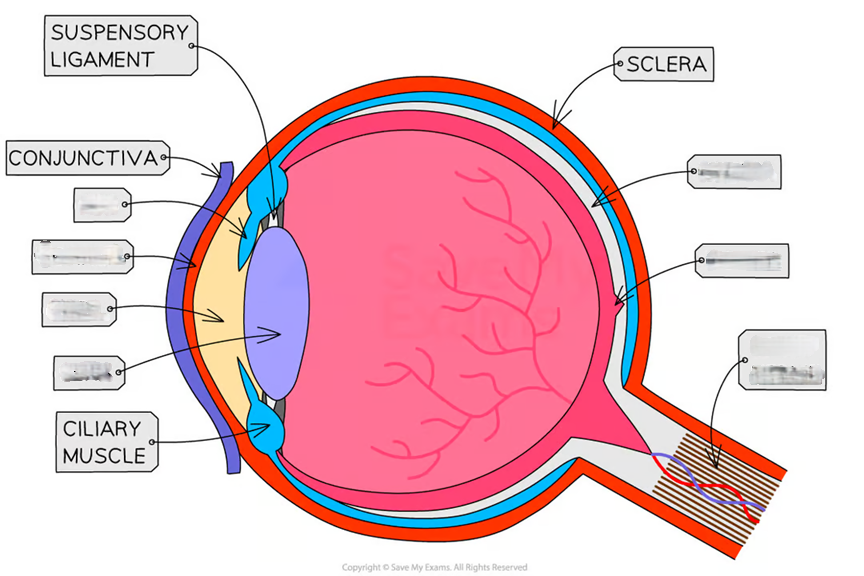
IDENTIFY

What are the parts of the eye
1) Cornea: Refracts light
2) Iris: Controls how much light enters the eye
3) Lens: Focuses light on to the retina.
4) Retina: Contains light receptors (rods and cones), some sensitive to light of different colours.
5) Optic nerve: Carries impulses to the brain.
Desribe the pupil reflex
The iris contains circular and radial muscles. These muscles work antagonistically; when one contracts the other relaxes. This antagonistic action controls how much light enters the eye.
Describe the pupil reflex in dim light
- Photoreceptors detect low light levels
- Radial muscles contract
- Circular muscles relax
- The pupil dilates (the diameter widens)
- More light enters the eye
Describe the pupil reflex in bright light
- Photoreceptors detect high light levels (bright)
- Radial muscles relax
- Circular muscles contract
- The pupil constricts (the diameter narrows)
- Less light enters the eye.
what is accommodation
Accommodation is the way in which the eye focuses on near or distant objects.
The shape of the lens is changed during accommodation, which alters light refraction, and this is controlled by ciliary muscles and suspensory ligaments in the eye.
Describe accommodation and near objects
- The ciliary muscles contract
- The suspensory ligaments loosen (less tension)
- The lens becomes more rounded as less tension of suspensory ligaments.
- Light is refracted more
Describe accommodation and distant objects
- The ciliary muscles relax
- The suspensory ligaments tighten (More tension)
- The lens becomes thinner as more tension of suspensory ligaments.
- Light is refracted less.
What are the receptors in the eye
Rods and cones are the photoreceptor cells present in the retina.
Describe the distribution of rods and cones
Rods and cones are not distributed evenly across the retina. Rod cells are found all over the retina except for the blind spot.
Cone cells are concentrated in the fovea.
Describe the functions of rods and cones
Rods are sensitive, so they can detect light at low levels, which is important for night vision.
Cones have three different kinds, detecting and absorbing light for different colour wavelengths. The cones allow for colour vision.
What is the fovea
The fovea is the region onto which light is focused by the process of accommodation. It enables the brain to form, sharp colour images when light is effectively focused onto it.
How do hormones travel in the bidy
Hormones travel in the blood.
What is the endocrine system
The glands that produce hormones is collectively known as the endocrine system.
What are the endocrine glands
Adrenal glands: Secrete adrenaline
Pancreas: Secretes Insulin and glucagon
Testes: Secrete testosterone
Ovaries: Secretes oestrogen
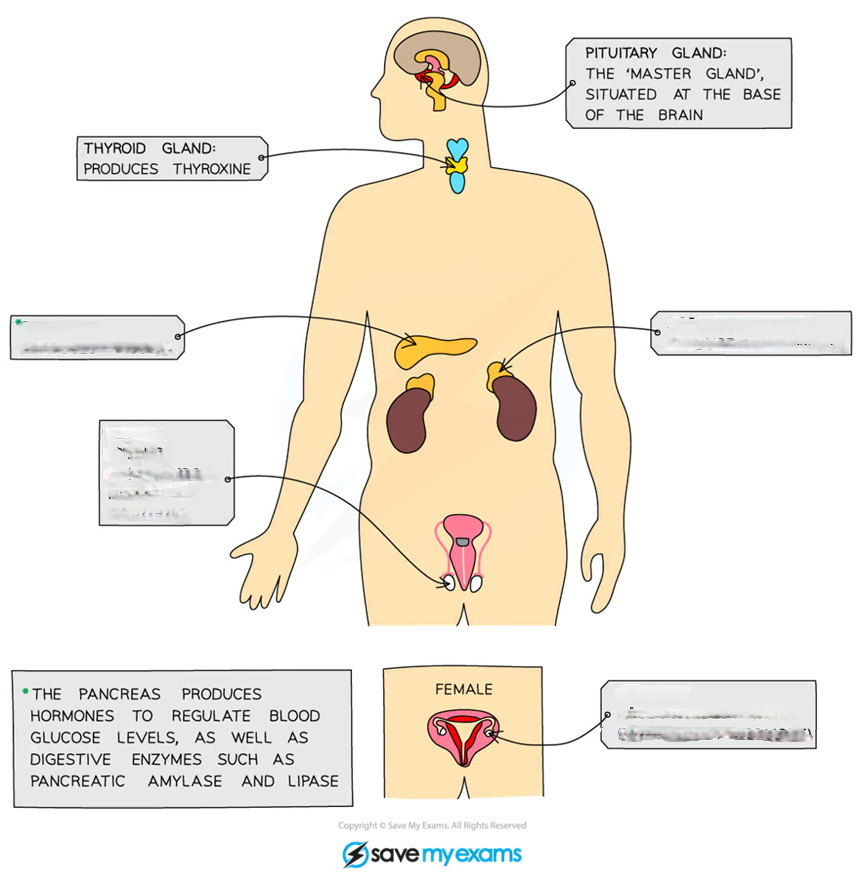
IDENTIFY ENDOCRINE GLANDS
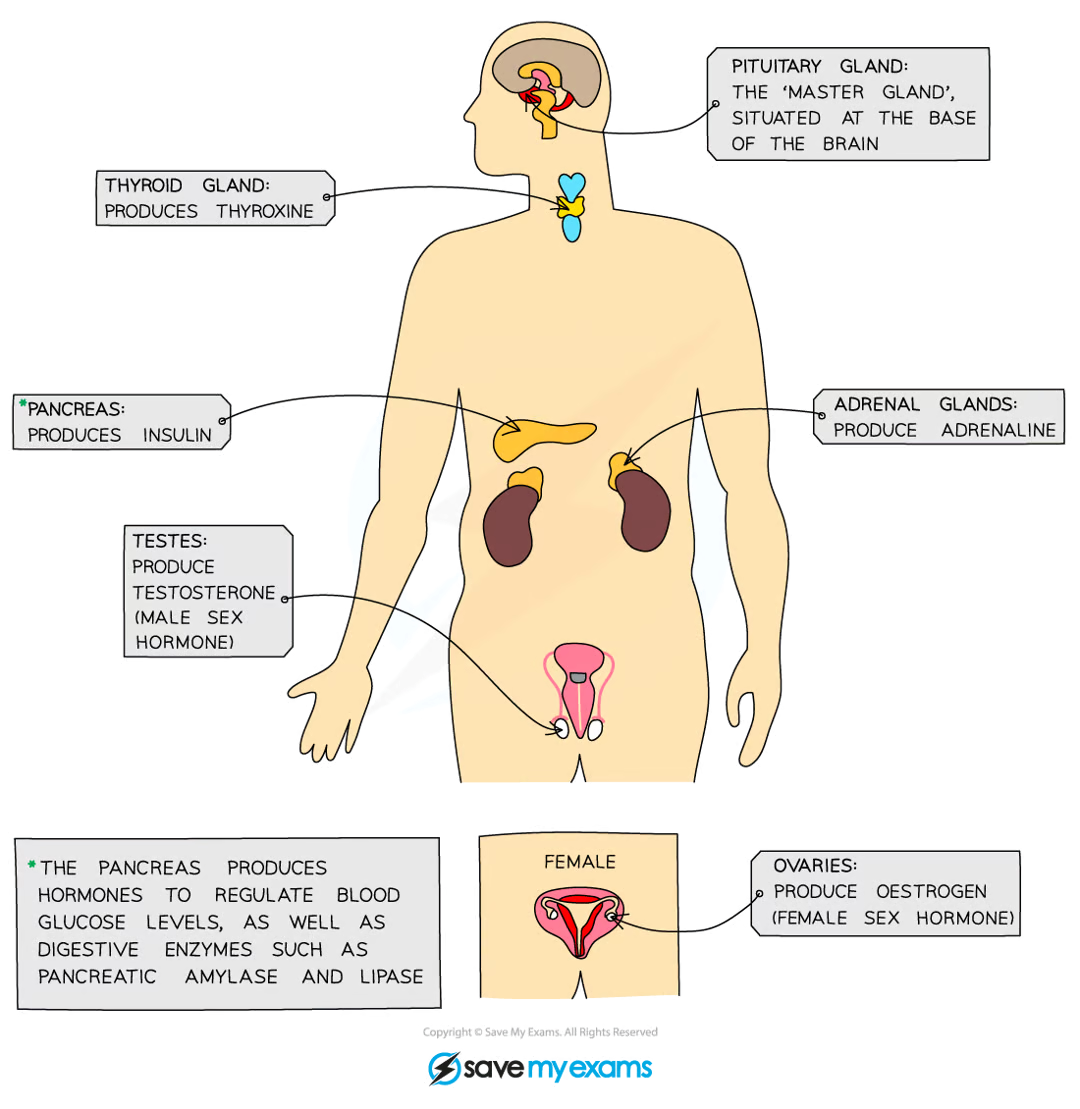
What does adrenaline cause:
1) An increased breathing rate and heart rate to deliver glucose and oxygen to muscle cells quickly, as well as remove carbon dioxide.
2) An increased pupil diameter (dilation) to allow as much light as possible to reach the retina so more information can be sent to the brain; more can be seen.
3) An increased blood glucose concentration for increased respiration in muscle cells.
Compare the nervous and hormonal system
Nervous system:
Made up of: Nerves, Brain, Spinal cord
Type of message: Electrical impulse
Speed of action: Very fast
Duration of effect: Short- until nerve impulses stop
Endocrine system:
Made up of: Glands
Type of message: Chemical hormones
Speed of action: Slower
Duration of effect: Longer - until hormone is broken down
Describe homeostatic control
Homeostatic control occurs by negative feedback.
Negative feedback is a process that maintains a stable internal environment that occurs when conditions change from the set point (the 'normal' and ideal point). It reverses any changes that occur from the set point.
Describe the negative feedback cycle
Conditions change from set point → Change is detected → Corrective mechanisms activate → Conditions are returned to set point → Corrective mechanisms are switched off.
How is blood glucose concentration controlled
Blood glucose concentration is controlled by a negative feedback mechanism by the liver.
What does the pancrea produce
The pancreas produces two hormones; insulin and glucagon.
Explain what happens when blood glucose concentration rises
When blood glucose concentration rises, insulin is produced by the pancreas and travels in the blood to the liver. This stimulates the liver to convert glucose into glycogen to be stored, which decreases the blood glucose concentration.
Explain what happens when blood glucose concentration falls
When blood glucose concentration falls, glucagon is produced by the pancreas and travels in the blood to the liver. This stimulates the liver to break down glycogen into glucose to be released into the blood stream, which increases the blood glucose concentration.
What is type 1 diabetes
Type 1 diabetes is a condition where blood glucose levels cannot be regulated as the insulin-secreting cells in the pancreas cannot produce insulin, meaning blood glucose levels are high.
Symptoms of type 1 diabetes
- Extreme thirst
- Tiredness
- Blurred vision
- Weight loss
How can type 1 diabetes be treated
1) injecting insulin. This causes the liver to convert glucose into glycogen, which reduces the blood glucose concentration.
2) Controlling diet by eating foods that do not cause large increases in blood glucose levels and controlling carbohydrate intake.
3) Exercising, which can lower blood glucose levels due to increased respiration in muscles.
4) Monitor glucose concentration in the blood or urine.
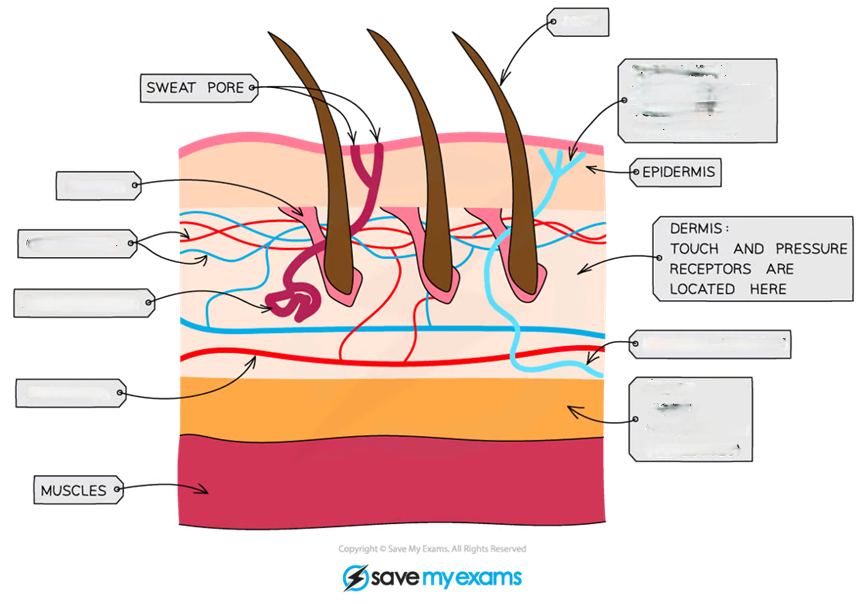
IDENTIFY
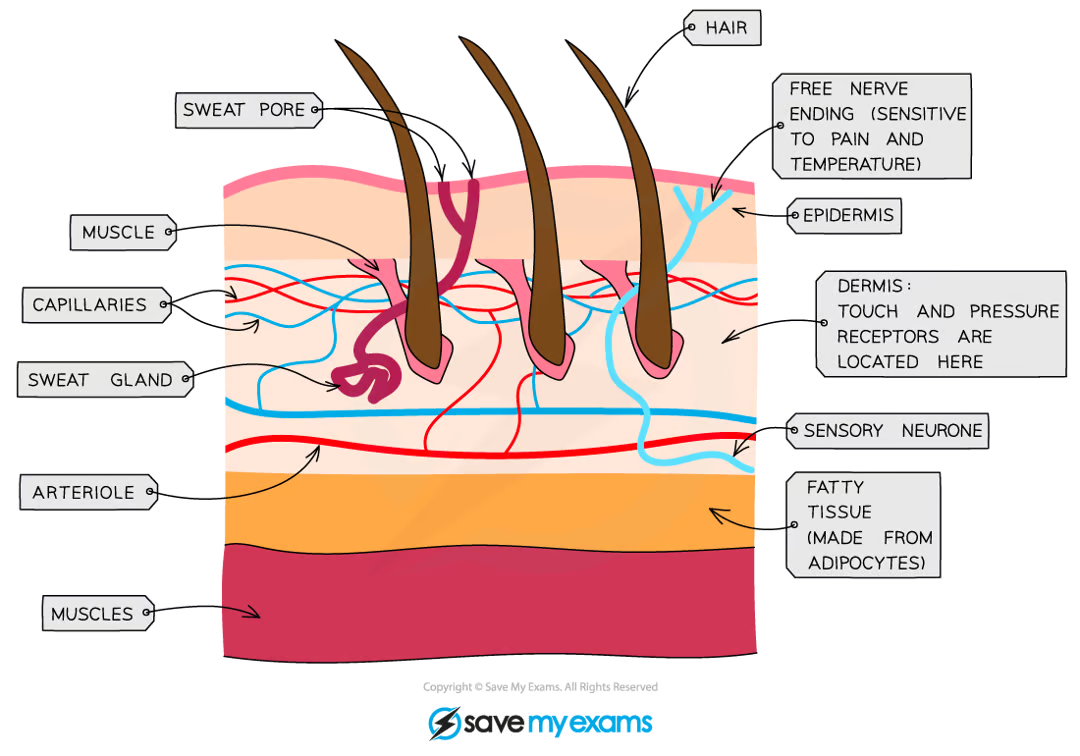
What is thermoregulation and the maintenance of a constant internal temperature
The set point of human body temperature is 37°C, which is the optimum temperature for enzymes.
The control of body temperature (thermoregulation) is a homeostatic process.
The brain and skin contain thermoreceptors that detect a change in the temperature of blood. The brain responses by sending electrical nerve impulses to effectors in the skin to maintain a body temperature of 37°C.
Describe the maintenance of internal temperature when body temperature is low (cold)
Insulation:
When body temperature is low (cold), fatty tissue in skin acts as a layer of insulation, preventing the excessive loss of heat from the body through the skin.
Hair erector muscles contract to make the skin hairs erect. This traps a layer of air around the skin which acts as an insulator, preventing heat loss by radiation.
Shivering:
Skeletal muscles contract rapidly, causing the body to shiver. These muscle contractions generate heat through respiration, which warms the body.
Describe the maintenance of internal temperature when body temperature is high (warm)
Hair erector muscles relax, and the hairs lie flat against the skin, allowing air to freely circulate, which increases the heat lost by radiation.
Sweating:
Sweat glands secrete sweat. Heat is lost as the sweat evaporates from the skin, cooling the body
Describe vasoconstriction when cold
Vasoconstriction is when arterioles connected to the skin capillaries get narrower, decreasing the blood flow in the capillaries. This reduces the amount of heat lost from the blood by radiation as less blood flows through the surface of the skin.
Describe vasodilation
Vasodilation is when arterioles connected to the skin capillaries get wider, increasing the blood flow to the capillaries. This cools the body as more blood is flowing through the skin's surface, which increases the heat lost by radiation.
What is the general outline of temperature control by the skin when body temperature rises
When body temperature rises, it is detected by receptors in the brain and skin, leading to increased sweating, vasodilation, and flattening of skin hairs, which returns body temperature to normal.
What is the general outline of temperature control by the skin when body temperature lowers
When body temperature lowers, it is detected by thermoreceptors in the brain and skin, leading to shivering, vasoconstriction, and skin hair erection, which returns body temperature to normal
What is a positive and negative tropism/response
When a plant grows towards a stimulus - Positive response/tropism
When a plant grows away from a stimulus - negative response/tropism
How do shoots and roots grow
Plant shoots grow upward, away from gravity and towards light, so they have a positive phototropic response and a negative gravitropic response.
Roots need to grow downwards into soil, away from light and towards gravity, so they have a negative phototropic response and a positive gravitropic response.
What is auxin
Plants produce the growth hormone auxin, which controls the direction of growth for roots or stems. Plants control their growth chemically.
What is the role of auxin
Auxin is made in the shoot tip, and diffuses through the plant from the shoot tip. Auxin stimulates cell elongation. It is unequally distributed in response to light and gravity.
Describe phototropism and chemical control
Auxin is evenly distributed throughout the cells if light shines all around the tip. However, when light shines from one side, the auxin produced in the tip diffuses to the shaded side and gets concentrated. This unequal distribution stimulates cell elongation on the shaded side, so it grows faster than the sunny side. This causes the shoot to bend and grow in the direction of the light.
Describe gravitropism and chemical control
Gravity modifies the auxin distribution so that it accumulates on the lower side of the shoot. As auxin increases shoot growth rate and stimulates cell elongation, the shoot grows upwards.